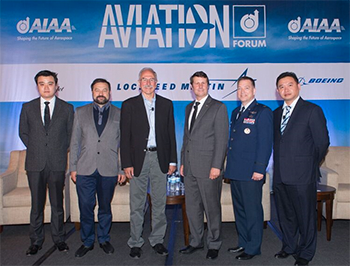Internet of Things Could Enable Drones to Change the World Written 9 June 2017
Panelists: moderator David Loda, executive director, NCPS Research LLC; Sam Kogan, chief executive officer, Gen5 Group LLC; Dave Kasik, senior technical fellow, Boeing; U.S. Air Force Col. Tim West, senior materiel leader, Test Operations Division, Arnold Engineering Development Complex; Zhennan Cao, president, STARC Solutions Ltd., China; Wu Hui, general manager, (HRG) HIT Special Robot Group Co. Ltd., China
by Lawrence Garrett, AIAA Web Editor

The “internet of things” will completely revolutionize the aviation industry, particularly through its application to the growing unmanned flight sector, a panel of experts said June 8 during the “Internet of Things as Applied to Aircraft Systems” session at the 2017 AIAA AVIATION Forum in Denver.
The internet of things is the networking of devices, vehicles, buildings and other items with electronics, software, sensors, actuators and network connectivity. The connected objects are able to collect and exchange data, which offers aerospace manufacturers a way to have real-time data communications with their deployed products.
David Loda, executive director of Connecticut-based NCPS Research LLC, explained that humans traditionally have had to manually harvest and collect data and then bring it back for design, but the internet of things is now providing an autonomous capability.
“We’re embedding intelligence onboard the asset where it’s actually occurring and then processing it onboard, and then creating a neuro-network type of global distributed intelligence that can then convert that data into information, to knowledge, to wisdom and actionable intelligence,” Loda explained.
Leveraging the lessons already learned through the application of the internet of things, Loda said that the industry is now at a “major shift point when it comes to industrial drones.”
“Drones are going to change the world from the commercial side,” Loda said, explaining that drones will create a “data explosion” through what they are looking at. “It’s all about visualization and also about algebraic computation of how we can use new ways to visualize, and understand and mine this data.”
Sam Kogan, CEO of Massachusetts-based Gen5 Group LLC, said he got involved with the internet of things a couple of years ago.
“It’s a new trend, a new enabling technology that will significantly effect a lot of businesses,” he said.
When it comes to the internet of things enabling drones or other products, Kogan said it’s important to keep in mind that it will completely change the business model. Using agriculture as an example, Kogan suggested that with a connected smart drone, fields for growing crops could change size and that today’s supply chain of equipment could no longer be needed.
But, he cautioned, “If you’re not going to address the main premise of value of all stakeholders in a value chain, in a supply chain, this technology will die.”
Kogan expressed his excitement about applying the internet of things to commercial drones, calling it “the future.” He noted that it will take a “complex approach in making sure that we have a great enabling data process to address the value drivers.”
David Kasik, senior technical fellow in visualization and interactive techniques at Boeing, agreed.
“Ultimately, what we want to do with all that data is not do something that I’ve termed to be write-only data stores, where you just store it and then nothing ever happens to it again,” he said. “You want to extract some value from it.”
Kasik said the value drones provide “is that now we add visual cues that supplement those digital ones that have been around for literally decades.”
U.S. Air Force Col. Tim Smith, who oversees ground testing at the Arnold Engineering Development Complex in Tennessee, cited a number of commercial drone applications: package delivery, agricultural monitoring, fire patrol, industrial facility inspections and “anything that’s hard to access.”
“There are a lot of hard things to inspect that could be done easier with a drone,” he said of his test facility.
Smith said he sees three big challenges that applying the internet of things to drones could help solve. The first is safety and ensuring that any given drop zone is clear, Smith said, noting for example, if someone’s dog is in the area, the “rules of engagement you build into a system” need to be able to handle that sort of problem.
He said the second challenge is interaction with other aircraft, including aircraft avoidance, the integration of drones into the national airspace and the question of how much autonomy to give these systems.
“And, how do you handle failures?” asked Smith, citing the third challenge, “Because things will go wrong.”
